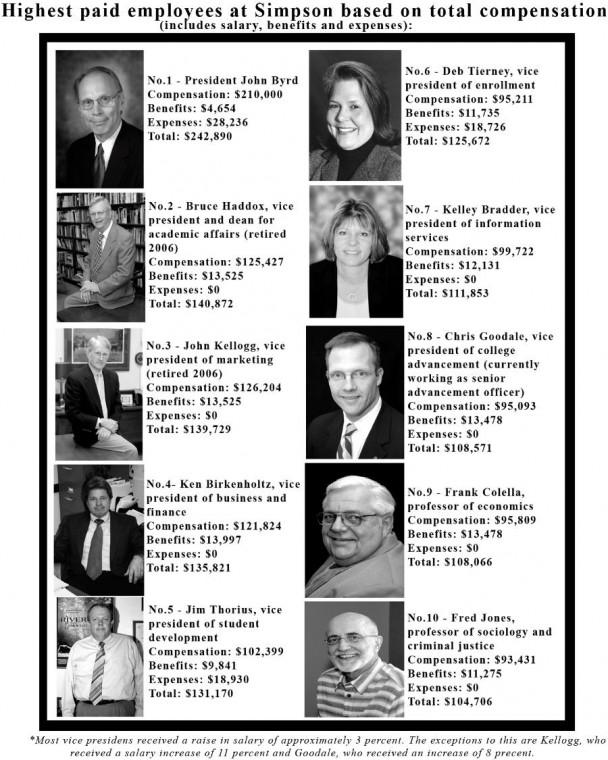Show me the money: Simpson’s 10 highest paid employees
March 21, 2007
The fall of 2005 ushered in a new president, and along with that new president came a new salary. President John Byrd started his tenure at Simpson College with a salary of $210,000 and a total compensation of $242,890.
“Realizing the qualifications of the individual they were bringing in and the market, that’s a fair compensation for a new president with Dr. Byrd’s qualifications,” said John Hartung, president of the Iowa Association of Independent Colleges and Universities. “As you can see from the track record, he’s really getting the job done.”
Total compensation includes benefits such as a retirement plan, health insurance and life insurance as well as expenses paid for by the college.
“What that can include is if any of those administrators have children that are going to school and are getting tuition exchange,” said Adam Voigts, assistant vice president for business services/controller. “It also includes car allowances…In President Byrd’s case, the big amount that’s in there is the house that he lives in that’s owned by the college.”
Byrd drives a yellow Hummer and lives in Sigler House as part of this compensation. The amounts listed on Form 990 aren’t the actual values of the items but are amounts it would cost to use the items.
“We estimated really roughly what the rental value would be if we rented it (Sigler House) out,” Voigts said. “It would be approximately $1,500 a month, which equals $18,000. We then add on $7,300 for the cost of utilities, repairs and maintenance and insurance.”
Byrd said the salary Simpson offered was not the most important factor he considered when deciding whether or not to work for the college, and little negotiating was done over the salary.
“The first and most important decision for me was that I really wanted to be at Simpson,” Byrd said. “After that, I looked for a competitive salary. I thought the contract offered by the institution was reasonable, and I accepted it without much discussion or negotiation.”
Byrd received a salary of $160,224 his last year as a vice president at the University of Evansville in Indiana. This is not much lower than his present salary, and many feel Byrd’s compensation isn’t unreasonable for all the time he puts into his position.
“The presidents at non-profit institutions have a job that’s 24 hours a day, seven days a week,” Hartung said. “They’re never really off duty, so the compensation, I believe, isn’t out of line.”
R. Kevin LaGree, Simpson’s president before Byrd, also received nearly $20,000 in total compensation this year.
“He was actually paid through June, and our year-end is May, so there was a month of pay in there,” Voigts said.
As The Simpsonian reported last year, LaGree received $246,368 in salary ($268,585 total compensation) his final year as acting president at Simpson. The $17,365 in salary ($19,254 total compensation) from the most recent fiscal year is on top of that amount.
“It had to do with a contractual obligation we were fulfilling,” said Steven Weeber, chairman of the board of trustees. “It has to do with some obligation.”
Weeber said Simpson doesn’t feel much competitive pressure when deciding the starting salary of executives like Byrd.
“There is always competitive pressure, but it’s for the most talented rather than for salary,” Weeber said.
Still, staying competitive with salaries is something colleges like Simpson constantly face.
“I think you’ve got a really good president in John Byrd, and certainly colleges are looking for good people,” Hartung said. “As a result of looking for good people, they find somebody who’s a skilled leader and understands the nuances of being a college president. They want to not only secure that person, but retain him. That’s where the pressure comes. There are folks out there looking all the time for new college presidents.”
Raising salaries to become more competitive is something universities across the nation face. This competitive pressure applies to all employees, not just presidents.
“I think with every employee group, whether it’s vice presidents, faculty members, or staff, we must work to keep our salaries attractive,” Byrd said. “If we don’t, it will get harder and harder to recruit and retain great people for Simpson.
Simpson is currently in the process of evaluating salaries to remain competitive and attract able employees to the college.
“Last spring we looked at staff and administrator salaries,” Byrd said. “This spring we are conducting a study of faculty salaries. That study will look at our salaries against benchmark institutions, review salary differentials between faculty ranks and determine if any gender equity issues exist within our current salary structure. We want to make sure that we have equity in the way that salary monies are distributed.”












